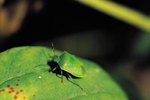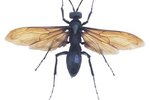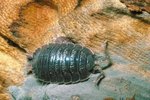
Thousands of species of leafhoppers exist worldwide, all belonging to the cicadellidae family. Fast-moving, they can hop forward, backward and sideways, like a crab. Adult leafhoppers will quickly fly away when disturbed. Specialized mouth-parts enable them to suck the juices from leaves, grasses and fruits. Leafhoppers are fast maturing insects, producing up to six generations per year. Some species migrate, some hibernate, and some have a short lifespan of weeks or months.
Physical Appearance
Leafhoppers are small insects, measuring a quarter to a half-inch long. They're slender with a blunt head, and their wings form a wedged shape over their body. Their hind legs have four rows of small spines running down them. Most leafhoppers are green or yellow, but their color varies by species, and many have mottled markings. Juveniles resemble adult leafhoppers, but their bodies are smaller and they don't have wings.
Reproduction
During spring and summer, leafhoppers inject their tiny eggs into leaf veins or stems. Their reproduction cycles vary, depending on the species. Some leafhoppers' eggs hatch in ten days, others go dormant for the winter and hatch in the spring. Hatchlings feed on the host plant, staying on the undersides of leaves where they are less noticeable to predators. After five molts, in a 12 to 30 day period, the juveniles become winged adults.
Habitat and Predators
Leafhoppers are found in temperate, tropical, and subtropical climates. They live in forests, deserts, grasslands, wetlands, agricultural fields and backyard gardens. Predators that threaten leafhoppers are birds, lizards, spiders, parasitic wasps and other insects. Leafhoppers make a soft, vibrating sound with flexible panels, called tymbals, on the undersides of their abdomens. Inaudible to humans, this distress call can startle predators, causing them to drop a captured leafhopper.
Ecological Impact
Leafhoppers damage the plants they feed on. Their sucking mouth-parts deposit a toxic saliva secretion in the leaves and stems, causing white or yellow bumps to appear. Hopperburn is when the leaves turn yellow or brown from leafhopper damage, causing stunted growth or death of the plant. Some leafhoppers carry and spread plant diseases, causing devastation to agricultural crops and certain plant species. Leafhoppers are an important food source for insectivores.
References
Photo Credits
-
Hemera Technologies/PhotoObjects.net/Getty Images
Writer Bio
Karen Mihaylo has been a writer since 2009. She has been a professional dog groomer since 1982 and is certified in canine massage therapy. Mihaylo holds an associate degree in human services from Delaware Technical and Community College.




